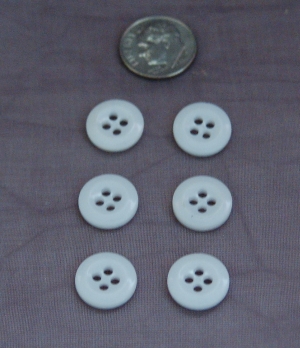Common buttons are classified by material, size and structure or connection option. The common plastic 4-hole buttons shown here are 1/2 inch in diameter.
These buttons are attached using the four holes which allows them to be sewn to a fabric backing using a needle and thread. Other buttons may offer a two hole attachment or attachment with a shank. That allows the button to be attached without showing the thread used. For strongest button attachments use a double thread. Before finishing, wrap thread around the attaching threads under the button. This gives the thread an extra layer of thickness to hold them stronger. An old secret is to use unwaxed dental floss because of the long, strong filaments.
Four hole buttons are the most common, white is the most common color and plastic is today’s most common material for buttons. So we can say these are an example of today’s most common buttons.
The value of buttons relates directly to their scarcity, the material and craftsmanship of manufacture and design and their age. Common buttons such as those shown here are used to replace missing buttons that match or to create a new garment or artpiece.

